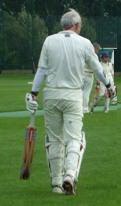This is a joke about probability and about the fallacy of induction. Each toss is an independent event with a 50/50 chance of either result - heads or tails. But we are certain that a never ending series of heads is impossible, so we are sure that the next toss must be tails. When it isn't, we become even more sure that the next will be. Casino owners make their fortunes out of this error of logic which is accordingly called the Monte Carlo Fallacy. On 18 August 1913, at the casino in Monte Carlo, the roulette wheel came up black a record twenty-six times in succession and with each spin there was an increasingly panicked rush to bet on red. Players doubled and tripled their stakes, believing that after black came up the twentieth time that there was not a chance in a million of another repeat. The unusual run enriched the Casino by some millions of francs. |
 |
| Not Monte Carlo |
Tradition has it that winning the toss is important and the subsequent decision also. All skippers have in the back of their minds WG Grace's advice that on winning the toss, you bat first, if in doubt, think about it and bat. But does the toss matter? And what of the decision?
Primarily a bowler for most of his career, FB has never quite taken Grace's advice to heart and unless presented with an absolute belter of a track (rare in lower leagues although artificials confuse thinking), usually preferred to bowl first - he could get his own work done, have a decent tea and relax while his batters did their stuff. This wasn't just selfish - as a bowling side, FB's team generally took more league points out of bowling first. Many years after these halcyon days, FB's instincts are still on the bowling first side.
But does the toss matter and does the decision matter? There being no analysis of lower league cricket, FB is forced to turn to some data on Test matches for instruction. Before 1945 there seemed to be a distinct advantage in winning the toss - with a 57:43 ratio of victory in favour of toss winning captains. More recently however that ratio has narrowed to 50:50, and this is an improvement on the 1990s when teams winning the toss actually lost more matches than they won (46% to 54%).
The data is similarly confusing on the choice to bat or bowl. Between 2000 and 2009, teams choosing to bat won 85 and lost 95 Tests, while teams sending the opponents in won 49 and lost 40 Tests (anorak wearers should note that this analysis excludes Bangladesh). So is there any advantage in batting first?
There are factors at play here - covered wickets and the more aggressive batting of recent times have changed the fine balance of the game. Successful 4th innings chases are getting higher. First day batting collapses are regular. Another headache for a captain batting first can arise with the follow-on. Enforcing the follow-on can stretch bowling resources to breaking point, and resulting injuries can affect performances in subsequent Tests. Since 1994, teams enforcing the follow-on have done no better than those not enforcing it. It is not surprising that not enforcing the follow-on, once rare, has become more popular in recent years. In 17 of the last 41 follow-on situations, over 40%, it was not enforced.
There is a similarly confusing picture in ODI. FB found this analysis of the top 5 nations:
- Australia: Batting First Win% – 65.67, Batting Second – 63.80
- India: Batting First Win % – 47.55, Batting Second – 54.86
- Sri Lanka: Batting First Win % – 50.68, Batting Second – 47.83
- England: Batting First Win % – 43.53, Batting Second – 56.41
- Pakistan: Batting First Win % – 56.25, Batting Second – 53.47
What does it tell us? England and India are good chasers. Australia win from any position. But there is little guidance for the confused skipper.
 |
| MS Dhoni - is he such a useless tosser? |
Overall all this blizzard of information and analysis may do nothing than confuse. But it may well suggest that captains winning the toss should, more often than not, choose to bowl. That is, FB is a better source of advice than WG Grace. The trend seems to be in FB's favour.
But let's look at it from another angle. MS Dhoni gets big licks as the best skipper in world cricket. But in 25 Tests to the end of 2010 he lost the toss on 18 occasions, but won 13 matches and drew 9. In 88 ODI he lost the toss 46 times but won 50 matches.
He therefore loses more tosses than he wins but whatever he does he bowls and bats the pants of the opposition. This is FB's new role model. FB's new strategy is to be like Dhoni and lose the toss. There is of course no more than a 50/50 chance of that happening. Or is there?


Interesting statistics regarding the declining use of the follow-on. The turning point seemed to be the Headingley Test of 1981 - the outcome of that match contradicted the received wisdom that enforcing the follow-on was in most cases a no-brainer. I suspect that the increasing fragility of bowling attacks, alluded to in previous posts, may also be a factor.
ReplyDeleteMany thanks - FB may return to this subject in future - he suspects there is a number of factors that can be identified.
ReplyDelete